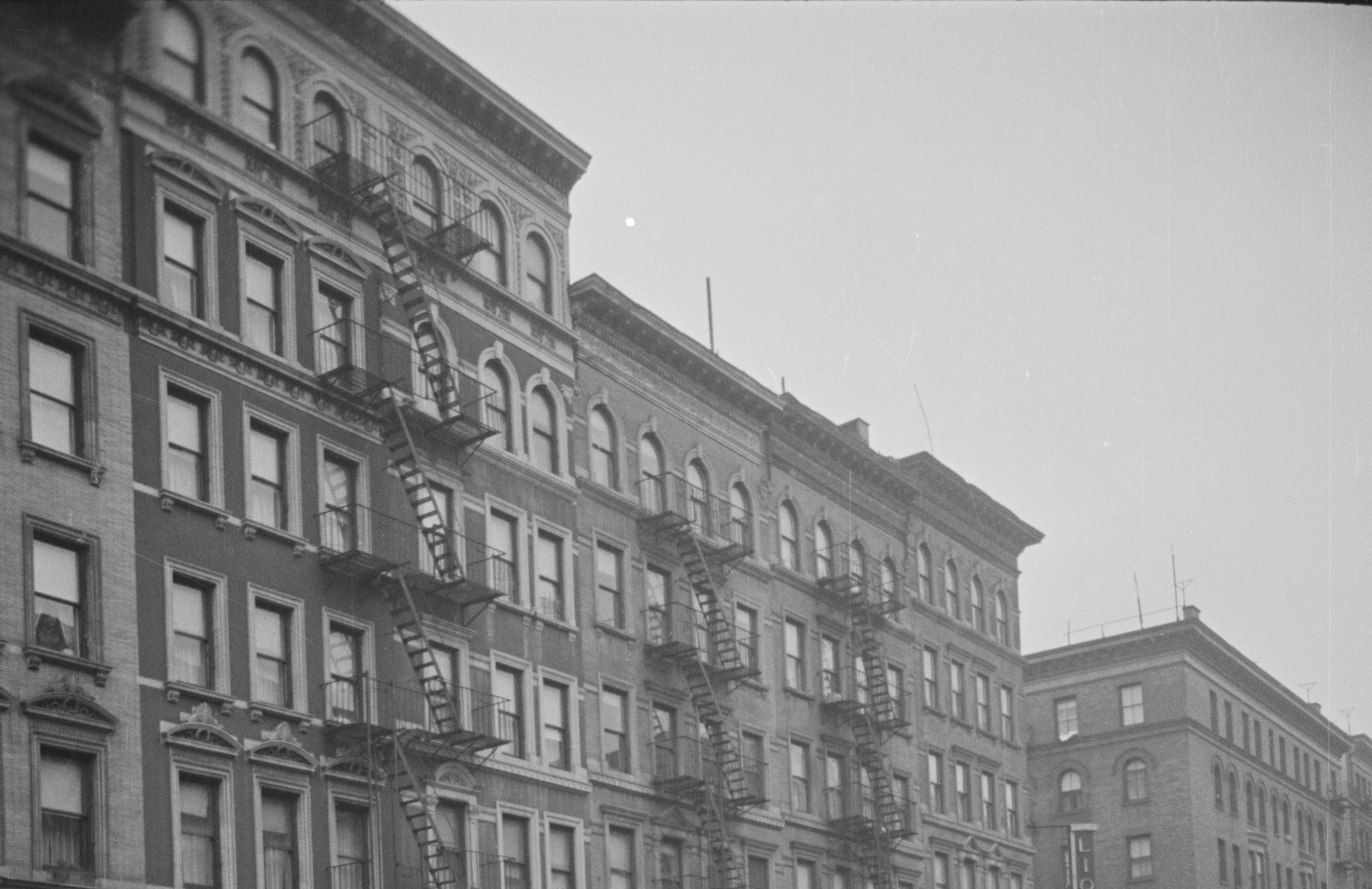
29-35 Manhattan Ave.
by Tom Miller
In 1897, developer William Rankin completed construction of four five-story brick flats, or apartment buildings, at 29 through 35 Manhattan Avenue. (The corner building, 35 Manhattan Avenue, had stores along the ground floor.) Designed by James W. Cole in the Renaissance Revival style, they were faced in red brick above a stone base. Each was slightly different, but their shared elements—like arched openings—created a harmonious flow.
There were seven apartments in each building—two each on the upper floors and one on the first. They filled with middle- and upper-middle-class tenants with wide-ranging professions. Among the first residents of 33 Manhattan Avenue was the wife and three sons of Count B. F. Torreas de Barros, who lived in Rio de Janeiro. Born in Pernambuco, Brazil in 1830, he was educated in Europe and lived as a young man in Paris. Around 1884 he was made Envoy Extraordinary and Minister Plenipotentiary in Venezuela. Count B. F. Torreas de Barros died in Rio de Janeiro at the age of 69 in February 1899. (It is unclear why he was living thousands of miles away from his family.)
Also living at 33 Manhattan Avenue at the time was 40-year-old bachelor Ernest L. Squire, a stockbroker. On April 5, 1900, he placed an advertisement in the New York Herald. It said, according to The Sun, “a wealthy family would educate and take care of a young girl of limited means who would have to perform some work in the house.” As it turned out, Squire was a sex offender.
The ad was answered by 15-year-old Viola Mann. Only a few days after she started working, Viola’s mother “removed her daughter from the house,” reported The Sun on April 15. Squire had, or attempted to have, sexual relations with the teenager. He was arrested on charges by the Society for the Prevention of Cruelty to Children (known familiarly as the Gerry Society), arraigned and released on $1,500 bail on April 14. The Society filed a suit for $25,000 damages (a staggering $965,000 in 2025 terms). Additionally, this was apparently not the first time Squire had used the ploy. An official from the Gerry Society said that “a Ruth Whiting, who is said to be 20 years old, left her home in Troy on March 18 in answer to an advertisement inserted by Squire. She soon left Squire’s apartments.”
…this was apparently not the first time Squire had used the ploy.
Squire’s case was scheduled for April 18. But he did not show up. Ruth Whiting, however, did. She had apparently learned of Viola Mann’s case and, according to The Evening World, “was in court prepared to make a criminal charge.” Officials attempted to find Squire, but he had abandoned his apartment at 33 Manhattan Avenue and could not be found.
Finally, more than two years later, on October 13, 1902, The Evening World reported, “Ernest L. Squires [sic], a man whom the Gerry Society has spent several thousand dollars in running down, was arraigned before Judge Cowing…to-day and remanded for trial.” The article said that after jumping bail, “he has been eluding the authorities. He was traced as far south as Mexico, and was finally located by Detective O’Brien of the Central Office, in Washington D.C.” Ernest L. Squire was in deep trouble. The article said, “An example will be made of Squire.”
A much more respectable resident of 33 Manhattan Avenue at the time was the Rev. William Wardlaw. Born in Belfast, Ireland in 1834, he immigrated to America and studied religion at Alexandria, Virginia. The New York Herald noted that he “preached to negroes during the civil war.” He came to New York City as assistant pastor of the Church of the Holy Communion on Sixth Avenue. He retired in 1898 for health reasons.
Actor William J. Constantine and his wife lived at 31 Manhattan Avenue in the first decade of the 20th century. Born in England in 1841, Constantine arrived in America in 1881. He played supporting roles in plays with stars like Richard Mansfield and Otis Skinner. In the spring of 1912, he took the role of a missionary in The Bird of Paradise. On March 15, he left his apartment “in very good health,” according to his wife, heading to the theater. That afternoon there was to be a benefit performance of the play for the Stage Children’s Fund. He began to step aboard a streetcar at Columbus Avenue and 102nd Street when he “was stricken,” as worded by The New York Times. A policeman picked him up and carried him into a nearby drugstore. When Dr. Oler from the J. Hood Wright Hospital arrived, the 71-year-old actor was dead.
August Schlosser lived in 31 Manhattan Avenue in 1914 when he came up with an inexpensive way to travel—riding on top of the express train to Albany. Unfortunately, he had not considered the dangers he would encounter. When the train pulled into the Albany Union Station early on the morning of August 25, he was discovered unconscious. The following day The Argus said he “is suffering from a fractured skull, a compound fracture of the left arm and other injuries.” Still unconscious, his condition was deemed critical.
Among Schlosser’s neighbors in 31 Manhattan Avenue was Edna E. Lohmann. The unmarried career woman worked as a bookkeeper for the Municipal Civil Service Commission. On January 18, 1915, she received a notable promotion, appointed to the position of Tabulator. Her new annual salary was $900, or about $29,000 today.
Harry S. Stanfield and his wife were also residents of 31 Manhattan Avenue. Harry was in the trucking business with his father until the elder Stanfield died in 1915. In March 1917, Harry Stanfield disappeared. His wife told officials, “Why he left home is a mystery.” In June, Harry’s mother, Elizabeth Stanfield, came to New York to help search for him. Then, on June 13, The Evening World reported that Elizabeth “is very ill…and her physician says she will die unless the young man returns. She continually calls for him.” (It is unclear if Harry Stanfield was ever found.)
Entertainer William H. Gibson lived at 29 Manhattan Avenue in the post-World War I years. The vaudevillian had a rather bizarre act. He wore a prosthetic leg and made $200 a week “chiefly for dancing on his artificial leg,” according to The Evening World. As he was crossing Manhattan Avenue on March 12, 1922, he was knocked down by an automobile driven by Basil N. Gunn. The two men faced off in court on October 3 after Gibson sued Gunn for $50,000 (nearly $950,000 today). The Evening World explained, “He says his artificial left leg was knocked off and the stump so infected that he is no longer able to wear an artificial limb.” He could no longer make a living, he asserted.
“He says his artificial left leg was knocked off and the stump so infected that he is no longer able to wear an artificial limb.”
William H. Gibson’s attorney brought “a motion picture machine” into the courthouse to provide evidence. It played a silent picture that vaudeville audiences would have normally seen. It showed Gibson getting his new leg and then asking for a job as a dancer.” At that point, the motion picture would end, and Gibson would come on stage to do his dancing act. (Whether Gibson won his suit is unclear.)
Agnes Tagney, who lived in 31 Manhattan Avenue, found a boyfriend in 1921. The problem was that Francis McDonnell was married. Things became ugly in the early hours of January 6, 1922, when Bridget McDonnell tracked down the wayward husband. She knocked on Agnes’s door and Francis called out that she could not come in. The Evening Telegram said, “The door went in first, followed by the determined little Mrs. McDonald.”
According to the article, “a phonograph horn was wrapped about McDonnell’s head, while a new radio set was sent flying across the room.” Agnes Tagney’s picture frames and furniture were thrown at the illicit lovers. Other tenants were awakened and shortly, “half a dozen police whistles shrieked in the night air.” When policemen finally separated the combatants, they were all arrested. The Evening Telegram reported, “McDonnell appeared in court with bandages covering lacerations of his head, while Mrs. Tagney appeared with dressings on her cheek and arms where, it was alleged, she had been bitten by Mrs. McDonnell.”
James W. Cole’s four handsome apartment buildings survived a few decades more. They were razed with dozens of other buildings for the sprawling Frederick Douglass Houses project, completed in 1958.
Tom Miller is a social historian and blogger at daytoninmanhattan.blogspot.com


